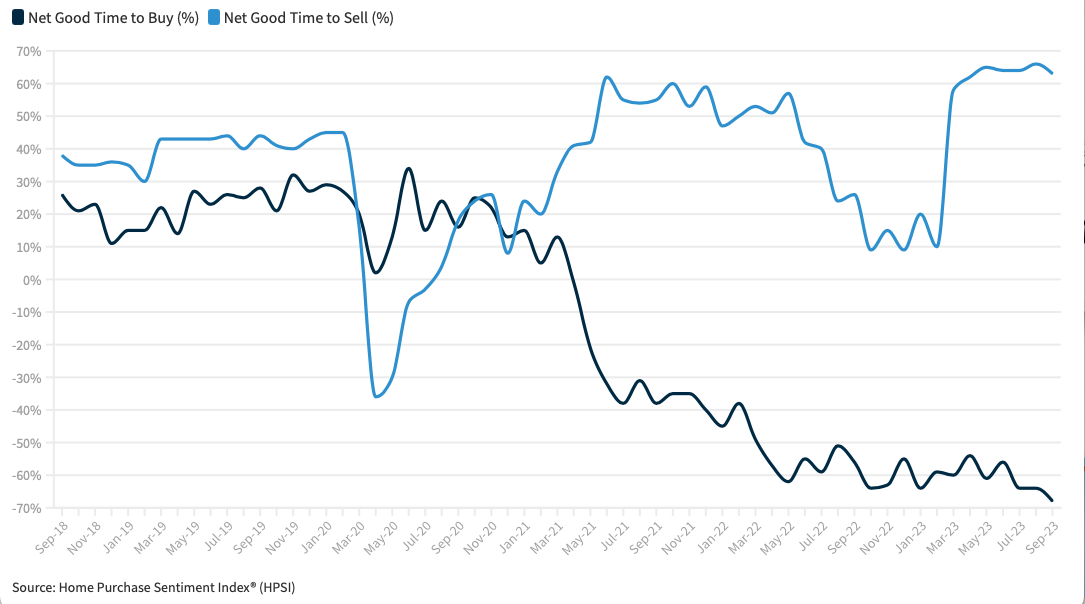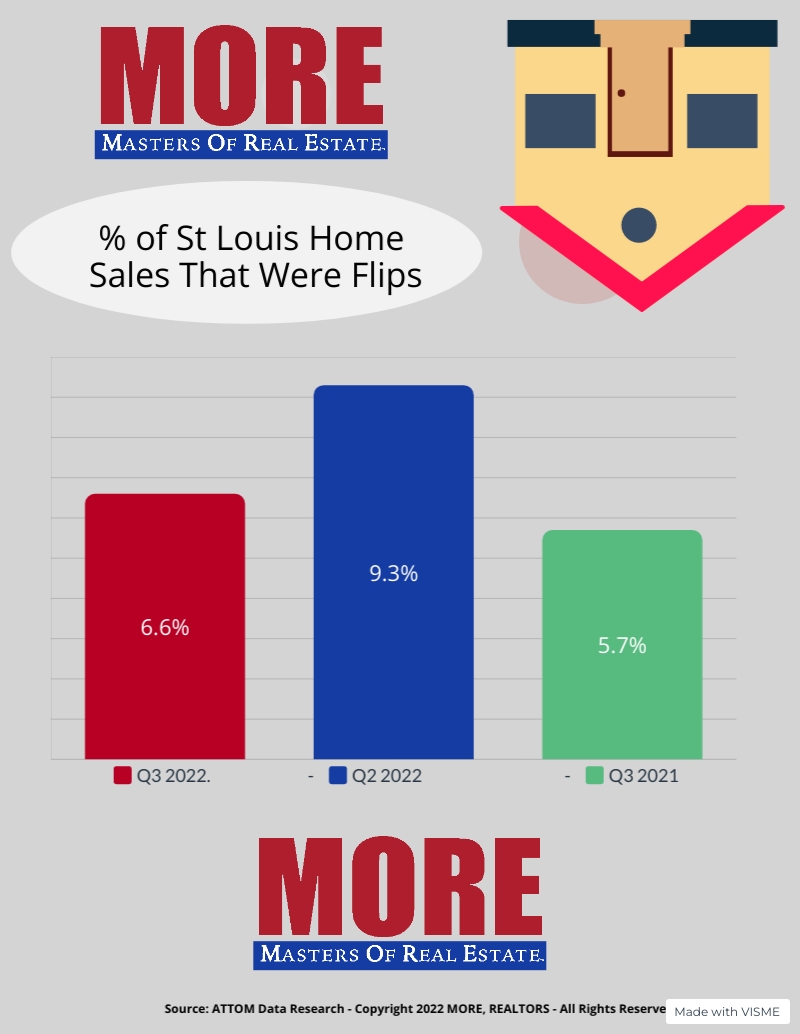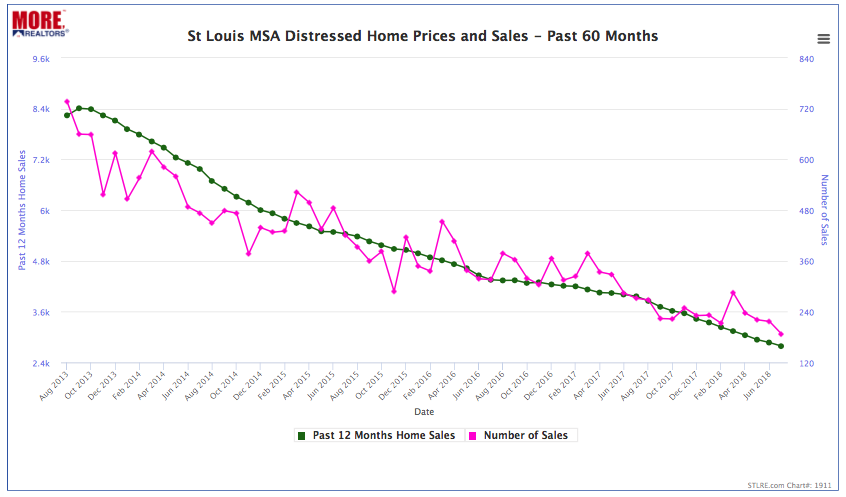If you’ve ever sat through a weekend “get rich with real estate” seminar, you’ve probably heard this pitch:
St. Louis is the affordable Midwest market with strong cash flow, stable renters, and easy entry points.
And for many investors, that sounds like the perfect recipe for a better retirement, a nest egg for the family, or a shot at financial freedom.
But here’s the truth: without the right guidance, St. Louis can turn from opportunity into nightmare—fast.
This is the real story of one out-of-state investor who trusted the hype, bought “off market” without local representation, and walked straight into a $150,000 mistake.
🎯 The Investor’s Dream
My client is a hard-working man in his mid-fifties living on the East Coast. Like many in his shoes, he was looking for a way to build long-term wealth and provide for his family.
He heard what countless others are told: “St. Louis is the place to buy.”
So he jumped in, wiring $150,000 for his first turnkey rental property.
- No Realtor® commissions (because it was an “off market” deal).
- A property management company already lined up.
- Fresh-looking siding and new stainless steel appliances.
- Promises of strong rent and easy passive income.
It looked like the perfect start.
🚨 The Reality Check: What Went Wrong
Within months, the shiny promises started peeling away—literally.
- Bad Tenants + Weak Management
The property management company was unresponsive. Their “repairs” were more about lipstick on a pig than real fixes. Within seven months, the tenants had to be evicted for nonpayment. - Vacancy = Higher Risk
During the turnover period, his brand-new furnace and stainless appliances were stolen. A stolen car was even dumped in the backyard. - Neighborhood Surprises
He installed cameras only to discover neighbors using his electrical outlets, kids climbing his trees, and strangers cutting through his property daily. - The Siding Illusion
That “new siding” from the distance photos? Up close, it was a patchwork of leftover pieces, spray-painted to match. - The Pricing Bombshell
When we pulled records, I had to deliver devastating news: the property had been on the market for months with no takers. The listing was canceled, only to close seven days later—with him paying tens of thousands more than the previous asking price.
❓ Why Do Out-of-State Investors Get Burned in St. Louis?
St. Louis is a complex market. Its very strengths—affordability, diverse neighborhoods, investor-friendly pricing—are what attract both legitimate buyers and predatory operators.
Here are the common traps:
- “Off Market” Doesn’t Mean Better
It often means no MLS data, no comps, and no protection. - Neighborhood Nuance
St. Louis is a block-by-block city. One street may be a rental goldmine; the next could be plagued with vacancy and crime. - Conflict of Interest in Management
Some turnkey sellers recommend (or own) the management company—so they’re getting paid twice, while the investor absorbs the risk. - Compliance Costs
From municipal occupancy inspections to lead-safe rules, new investors often underestimate the true cost of staying compliant.
🎤 But Wait—Do These Seminars Ever Work?
Here’s the truth: the people on stage running these weekend investor bootcamps? Many of them really are successful investors.
So yes—can it work? Absolutely.
But here’s the difference:
- They know how to vet properties, management companies, and contractors.
- They’ve built teams who protect their money when they invest out-of-state.
- They understand the neighborhoods where they’re buying—sometimes because they’ve lived there or studied the market for years.
You, the brand-new investor? You don’t have those systems yet. And that’s where the danger lies.
They may be friendly. They may seem incredibly helpful. But at the end of the day, they don’t protect you if the deal goes sideways.
Their bank account doesn’t take the hit—yours does.
Think of it this way: watching a celebrity chef on TV might inspire you to try soufflé at home. But if you don’t know how to separate the eggs or preheat the oven correctly, you’re more likely to end up with a collapsed mess than a five-star dessert.
It’s not that soufflé doesn’t work. It’s that you need the skill and support before you can pull it off.
🧮 The Numbers Have to Work (“The Math Has to Math”)
One of the biggest mistakes new investors make is treating their first property like an emotional purchase.
They fall in love with the idea of passive income. They get excited by the photos. They want to believe the pitch.
But here’s the reality: real estate investing is a numbers game.
- If the rent doesn’t cover your mortgage, taxes, insurance, and reserves, it’s not a deal.
- If the rehab budget is too low to fix the real problems, it’s not a deal.
- If you can’t see a path to positive cash flow in the first year, it’s not a deal.
That’s why I tell my investor clients: “The math has to math.”
Once the numbers line up, then it’s time to pull the trigger. That first successful deal becomes the foundation for many more. But you’ve got to have the confidence that the person you’re working with is truly interested in your success—not just in selling you a property.
🏘️ Why Having a Realtor Who’s Also an Investor Matters
Here’s where my perspective comes in: I’m not only a Realtor® in St. Louis—I’ve personally owned rental properties and flipped homes for profit.
That means I don’t just run the numbers on a spreadsheet; I’ve lived what it means to handle tenants, manage contractors, and make (or lose) money on a deal.
When I walk a property, I’m looking at it through both lenses:
- As a Realtor® trained to protect your legal and financial interests, and
- As an investor who knows the difference between a money-maker and a money pit.
That combination is exactly what was missing in my client’s first purchase—and it cost him dearly.
📊 St. Louis Investor FAQs
Q: Is St. Louis still a good place to invest in 2025?
A: Absolutely—if you’re strategic. Properties priced right in stable neighborhoods still deliver strong returns. The key is local expertise and due diligence.
Q: Can’t I just trust a property manager recommended by the seller?
A: That’s like asking a used car dealer to pick your mechanic. Always interview multiple managers and ask for references from current clients.
Q: How do I know if I’m overpaying?
A: A Realtor® with access to MARIS MLS can pull comps, rental histories, and days-on-market data that “off market” sellers won’t show you.
✅ How to Avoid a $150K Mistake
If you’re considering buying in St. Louis, here’s your investor safety checklist:
- Work with a Realtor® who understands investing firsthand. Not just someone who sells houses, but someone who’s owned them, managed them, and flipped them.
- Get independent inspections. Don’t trust seller-provided reports.
- Check neighborhood trends. Look at vacancy rates, crime reports, and appreciation patterns.
- Verify rent comps. Use MLS data and public records, not seminar slides.
- Budget realistically. Factor 10–15% vacancy/maintenance—not the 2% “pro forma” number often pitched.
📝 Final Word
St. Louis offers incredible opportunities for investors—but it’s not a city you can buy into blindly.
For my client, the difference between a solid portfolio and a six-figure mistake came down to one choice: he had no one protecting his interests.
If you’re thinking about investing here, don’t let your first $150K be a tuition payment in the school of hard knocks.
I’ve worked with first-time investors, out-of-state buyers, and seasoned pros alike. Before you buy, let’s talk strategy, neighborhoods, and numbers—so your story ends with cash flow, not caution tape.
Karen Moeller
STLKaren.com
Karen.McNeill@STLRE.com
314.678.7866
According to ATTOM’s Q1 2025 U.S. Home Flipping Report, home flipping remained an active segment of the real estate market in both Missouri and Illinois, although investor performance varied. In Missouri, 1,576 homes were flipped during the quarter, representing 11.0% of all home sales—well above the national average. Flippers in Missouri earned a median gross profit of $36,000, which translated to an 18.0% return on investment (ROI). Meanwhile, Illinois saw higher profitability with 2,001 flips and a 6.5% flipping rate. The median gross profit for Illinois investors reached $85,981, yielding a strong ROI of 52.8%. While Illinois investors had to hold properties longer—averaging 182 days compared to Missouri’s 165 days—the higher margins more than compensated for the wait. The ATTOM report reflects how flipping conditions can differ sharply even between neighboring states, emphasizing the importance of market-specific strategies and cost structures for investors seeking consistent returns.
For buyers, sellers, or investors in the St. Louis area looking to navigate the local real estate landscape—whether you’re flipping, buying, or selling—working with a knowledgeable agent from MORE, REALTORS® can help you make informed decisions with local expertise and proven results.
Every month, Fannie Mae surveys consumers to gauge their sentiment on whether it’s a good time to buy or sell a home. The results are published in their Home Purchase Sentiment Index® (HPSI). In the most recent HPSI report, 84% of respondents said they felt now was a bad time to buy a home. This is the highest percentage holding this view since the survey’s inception in 2012.
On the flip side, 63% of those surveyed believed now was a good time to sell a home. This is a slight dip from last month’s 66%.
As for interest rates, a mere 17% of consumers expect mortgage rates to decrease in the next 12 months
The St. Louis real estate market is experiencing a fascinating divergence in trends between luxury and non-luxury homes. According to the latest data from MORE, REALTORS®, the market for luxury homes—those priced at $750,000 and above—is on the rise, reaching its highest level in eight months. In contrast, the market for non-luxury homes, priced below $750,000, has been on a steady decline for about two years. This article delves into these trends, referencing two illuminating charts from MORE, REALTORS®.
Luxury Home Sales on the Upswing
The first chart from MORE, REALTORS® illustrates the upward trajectory of luxury home sales in the St. Louis area. As the chart shows, for the 12-month period ended September 30, 2023, there were 1,351 luxury homes sold in the combined markets of the city and counties of St Louis and St Charles County, which is the highest 12-month trend since January of this year.
There were 788 homes and condominiums “flipped” during the second quarter of this year in the St Louis M.S.A., according to data just released by ATTOM Data Solutions. As the infographic below illustrates, these flips represent 8.7% of all sales during the quarter, a decrease of 23.9% from the prior quarter and a decline of over 22% from a year ago.
As of April 1, 2023, the Federal Emergency Management Agency (FEMA) has put into action the National Flood Insurance Program’s (NFIP) Risk Rating 2.0, a newly devised pricing methodology. According to FEMA, this contemporary approach to flood risk assessment uses state-of-the-art technology and conforms to industry’s highest standards. The aim of this new model is to ensure that FEMA provides flood insurance rates that are not only actuarially justified, but also more equitable and comprehensible, and most importantly, they accurately represent the flood risk associated with a specific property.
There has been a fair amount of negative reports about the change in flood insurance pricing with 77% of the people with flood insurance seeing an increase in premiums as a result. For Missouri, 29.3% of homeowners with flood insurance will see a decrease in their flood insurance premium as a result with about 40% of these decreases being $50 per month or more. On the flip side, 62.4% will see an increase up to $10 per month, 6.1% with an increase from $11 to $20 per month and just 2.2% of the homeowners will see their flood insurance premiums increase by more than $20 per month.
Resources for more information on FEMA’s Risk Rating 2.0 as well as flood insurance:
There were 900 homes and condominiums “flipped” during the third quarter in the St Louis M.S.A., according to data just released by ATTOM Data Solutions. As the chart below illustrates, these flips represent 6.6% of all sales during the 3rd quarter of 2022, a decrease of 28.8% from the prior quarter but an increase of over 15% from a year ago.
[xyz-ips snippet=”Foreclosures-For-Sale-and-Homes-For-Sale”]
St Louis Home Flipping Trends
There were 94,766 homes and condominiums “flipped” during the third quarter in the U.S., according to data just released by ATTOM Data Solutions. These flips represent 5.7% of all homes sales during the 3rd quarter of 2021, an increase of nearly 12% from the prior quarter when 5.1% of all homes sold were flips.
Gross profit margins dip to the lowest point since early 2011…
According to the report, the gross profit margin (the difference between the price paid for the flipped house when purchased versus the price paid by the new buyer when flipped) was $68,847. This represents a 32.3% gross margin, the lowest gross margin percentage since the first quarter of 2011.
[xyz-ips snippet=”Foreclosures-For-Sale-and-Homes-For-Sale”]
U.S. Home Flipping Trends – Chart
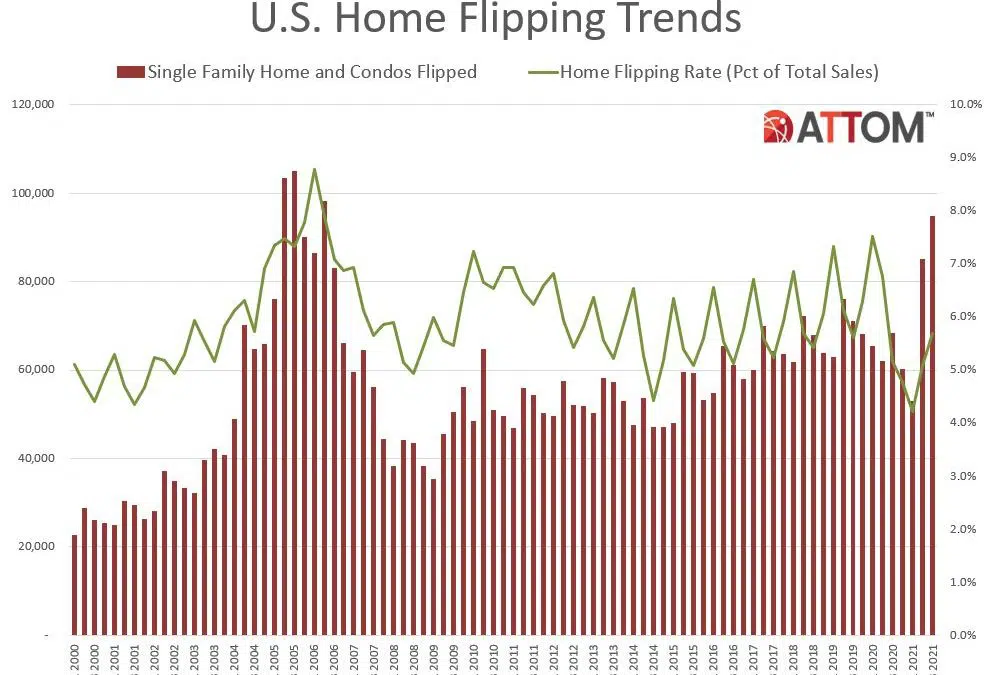
As the charts below illustrate, at the beginning of this year, mortgage interest rates for a 30-year conforming conventional loan were at 2.771%, FHA loans were at 2.703%, and VA loans were at 2.372%. As of yesterday, those rates have increased to 3.357%, 3.468%, and 3.101% respectively.
While conforming 30-year conventional loans have seen an increase of 21% in rates (from 2.771% to 3.357%), FHA loans have seen an increase of 28% (from 2.703% to 3.468%) and VA loans have seen an increase of 30% (from 2.372% to 3.101%).
What does this mean in terms of the cost of a home?
To make the comparison simple, I’ll just base my comparison on the price of a “typical” home in the St Louis 5-county core market using the median price of homes sold in October which was $234,900. Downpayments will vary based upon loan type from no downpayment being required on a VA loan, to a minimum of 3% on a conventional and 3.5% on an FHA but based upon a loan amount equal to the median price of $234,900, below are the differences in the monthly payment on that amount by loan type from the beginning of this year until now:
- Conventional – $948 to $1,023
- FHA – $939 to $1,038
- VA – $898 to $990
If we factor in the increase in home prices, it gets worse.
In the “to add insult to injury” category, home prices have increased significantly since January as well, In January the median price was $215,000, so between then and October the median price of a St Louis home increased 9.2%. With the interest rates increasing at the same time the cost of a typical St Louis home increased fairly significantly as shown below:
- Conventional – $867 to $1,023 (+18%)
- FHA – $859 to $1,038 (+21%)
- VA – $821 to $990 (+21%)
The moral of the story…don’t wait to buy.
While I certainly can’t predict the future, especially given all the uncertainty in our economy with inflation, employment issues, etc, if I were in the market to buy a home I don’t think I would wait “until things get better”. The reason for my opinion is, as I’ve illustrated here, the true “cost” of a home (assuming you are not paying cash for it) is a combination of price and interest rate. So, even if home prices see an adjustment or the seasonal dip we often see during winter if interest rates continue to rise, is the higher cost of borrowing going to offset the lower price? I think that is a possibility. Or, the flip side, if interest rates go down but then prices go up, is the savings in lower rates lost?
To benefit from waiting, in terms of the cost of the home, we would need interest rates to stay the same, or decline and home prices to decline or interest rates to drop and home prices stay the same. Right now I don’t see either of the two aforementioned scenarios likely to happen.
Continue reading “Mortgage Rates Have Increased Significantly This Year“
There were 542 homes “flipped” in the St Louis metro area during the first quarter of 2020, or 8.5% of the total number of homes sold in the St Louis metro area during the quarter, according to data just released by ATTOM Data Solutions. This is an increase of 13.8% from the prior quarter and is a decrease of 2% from a year ago. The median gross profit was 52,900 a 60.8% gross ROI.
Definition of a “flipped” home…
For the purposes of this report, a flipped home is considered to be any home or condo that was sold during the first quarter of this year in an arms-length sale that had previously had an arms-length sale within the prior 12 months. Since homeowners don’t tend to buy a home only to turn around and resell it within a year, when this does occur it is typically the result of an investor buying a property, renovating it, then reselling it.
[xyz-ips snippet=”Foreclosures-For-Sale-and-Homes-For-Sale”]
St Louis House Flipping – 1st Quarter 2020
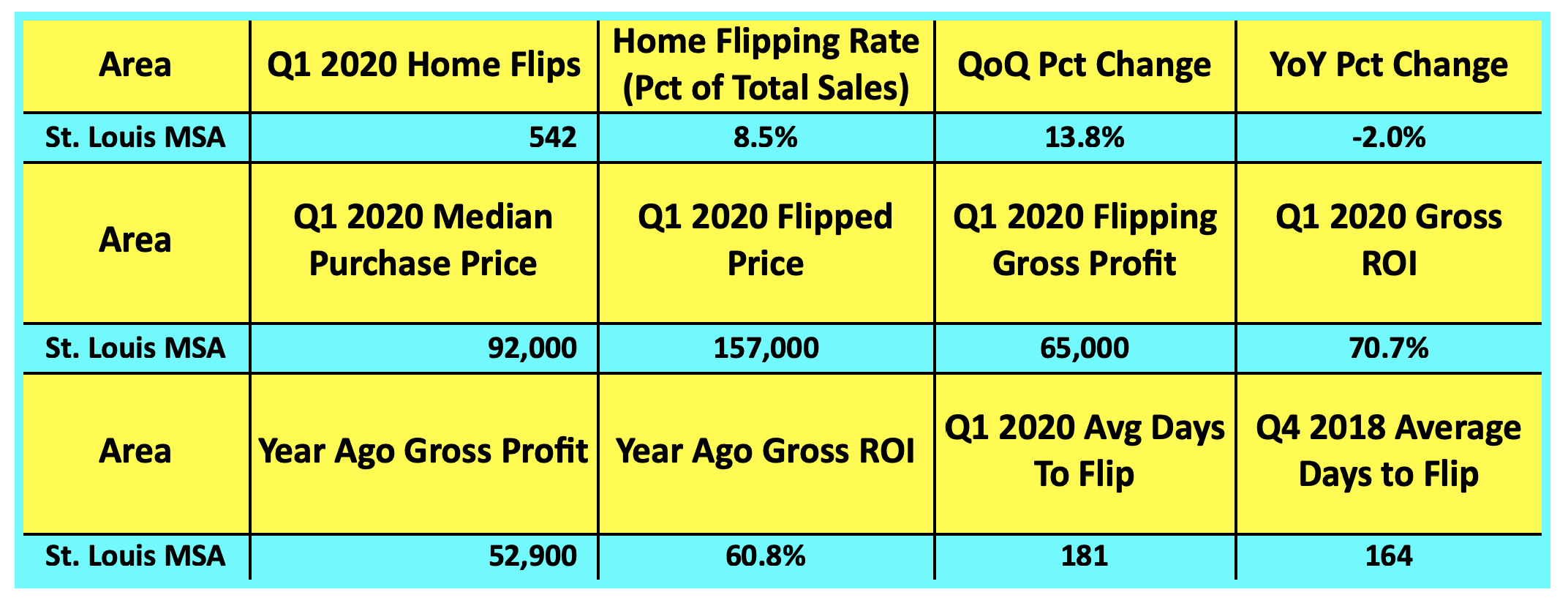 © 2019 – St Louis Real Estate News, all rights reserved
© 2019 – St Louis Real Estate News, all rights reserved
While we deal with the coronavirus (COVID-19) pandemic practicing social-distancing, shutting down events, public gatherings and the like, we are still trying to go on with our lives at the same time. A big challenge to this is the unknown; not knowing how bad things will get, how long we may have to live like this, etc. Fortunately, for those of us in Missouri, at the time I’m writing this, we have just 41 confirmed cases putting Missouri at number 40 of the 50 states in terms of the number of cases. Granted, once more people are tested, our position may raise, but hopefully, due to the swift action by our leaders and citizens here, it will not rise anywhere close to the levels we are seeing in some states, including our neighbor to the east, Illinois where there are 423 cases as of this morning.
What effect is the coronavirus having on St Louis real estate?
Continue reading “The Effect of Coronavirus (COVID-19) On The St Louis Real Estate Market“
There were 737 homes “flipped” in the St Louis metro area during the fourth quarter of 2019, or 7.2% of the total number of homes sold in the St Louis metro area during the quarter, according to data just released by ATTOM Data Solutions. This is an increase of 9% from the prior quarter and is a decrease of 6% from a year ago. The median gross profit was 64.450 a 71% gross ROI and a significant increase from a year ago when the Gross ROI was 54.1%.
Definition of a “flipped” home…
For the purposes of this report, a flipped home is considered to be any home or condo that was sold during the first quarter of this year in an arms-length sale that had previously had an arms-length sale within the prior 12 months. Since homeowners don’t tend to buy a home only to turn around and resell it within a year, when this does occur it is typically the result of an investor buying a property, renovating it, then reselling it.
[xyz-ips snippet=”Foreclosures-For-Sale-and-Homes-For-Sale”]
St Louis House Flipping – 4th Quarter 2019
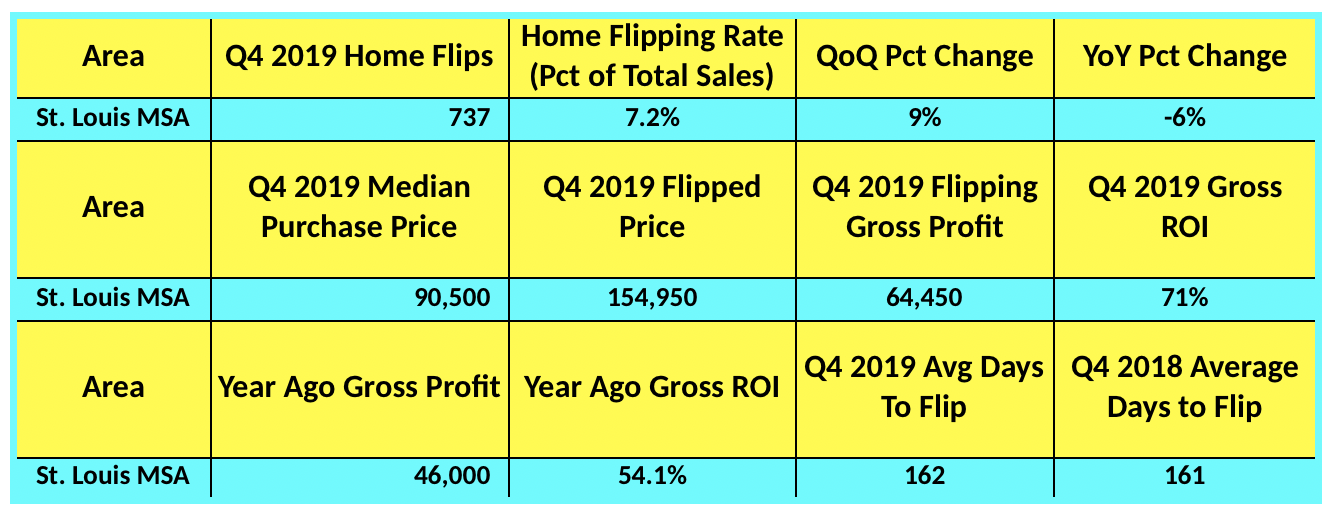 © 2019 – St Louis Real Estate News, all rights reserved
© 2019 – St Louis Real Estate News, all rights reserved
Let me begin with this is not a political statement and the purpose of this site is not about politics but about real estate. Having said that, this morning I came across the plans for the housing market that Bernie Sanders is proposing if he is elected President which I had not seen before. Upon reviewing his plan (it is on his official site) I realized that while many of the components of it sound good (like “End homelessness and ensure fair housing for all”) many of his promises in this area sound like things that would negatively impact investors and the housing market as a whole.
The following are the Key Points to the Bernie Sanders housing plan from his website (I have included the complete list):
- End the housing crisis by investing $2.5 trillion to build nearly 10 million permanently affordable housing units.
- Protect tenants by implementing a national rent control standard, a “just-cause” requirement for evictions, and ensuring the right to counsel in housing disputes.
- Make rent affordable by making Section 8 vouchers available to all eligible families without a waitlist and strengthening the Fair Housing Act.
- Combat gentrification, exclusionary zoning, segregation, and speculation.
- End homelessness and ensure fair housing for all
- Revitalize public housing by investing $70 billion to repair, decarbonize, and build new public housing.
Under the “When Bernie is president, he will” section are some of the things he plans to do to accomplish the above goals (this list is rather extensive on his site so I have only included a sampling of the items that appear will negatively impact investors and homeowners):
- Enact a national cap on annual rent increases at no more than 3 percent or 1.5 times the Consumer Price Index (whichever is higher) to help prevent the exploitation of tenants at the hands of private landlords.
- Allow states and cities to pass even stronger rent control standards.
- Implement a “just-cause” requirement for evictions, which would allow a landlord to evict a tenant only for specific violations and prevent landlords from evicting tenants for arbitrary or retaliatory reasons.
- Place a 25 percent House Flipping tax on speculators who sell a non-owner-occupied property, if sold for more than it was purchased within 5 years of purchase.
- Impose a 2 percent Empty Homes tax on the property value of vacant, owned homes to bring more units into the market and curb the use of housing as speculative investment.
Again, this is not a political piece, but given the strong housing market we have enjoyed over the past several years, which has helped many Americans build equity and recover wealth lost during the housing bubble burst of 2008, I think it’s worth noting proposed plans, by any party or power, that could negatively impact the market. Also, these are just talking points from someone running for office, so whether it’s Bernie Sanders or any other candidate, or even the current President, Donald J. Trump, they can all have ideas but getting them implemented takes cooperation of Congress and that is not always so easy so it doesn’t mean any of their plans ever actually come to fruition.
There were 762 homes “flipped” in the St Louis metro area during the third quarter of 2019, or 6.3% of the total number of homes sold in the St Louis metro area during the quarter, according to data just released by ATTOM Data Solutions. This is a decline of 15% from the prior quarter as well as a 5% decrease from the prior year. As our table below shows, on a national level, house flipping accounted for just 5.4% of the homes sold during the 3rd quarter of this year, which is a 9% decrease from the quarter before and a 4% increase from a year ago.
Definition of a “flipped” home…
For the purposes of this report, a flipped home is considered to be any home or condo that was sold during the first quarter of this year in an arms-length sale that had previously had an arms-length sale within the prior 12 months. Since homeowners don’t tend to buy a home only to turn around and resell it within a year, when this does occur it is typically the result of an investor buying a property, renovating it, then reselling it.
[xyz-ips snippet=”Foreclosures-For-Sale-and-Homes-For-Sale”]
St Louis House Flipping – 3rd Quarter 2019
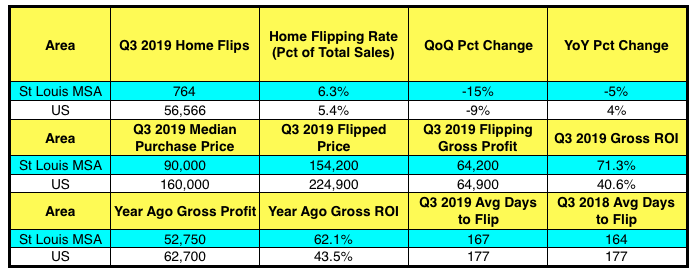 © 2019 – St Louis Real Estate News, all rights reserved
© 2019 – St Louis Real Estate News, all rights reserved
St Louis is the top marketing for flipping homes, according to an article published yesterday on Realtor.com. It’s not all just flipping activity however in the article a very notable and credible St Louis industry source (unabashed self-promotion) stated that “flipping is more common in homes in the $175,000-plus range, while many of those listed for $125,000 and less are being turned into rentals, says Norman.”
The Realtor.com article gave an overview of the market data I produced for them so I wanted to share the market data behind the overview.
St Louis Neighborhoods With Large Investor Presence:
- 63137 Zip Code Area (Bellefontaine Neighbors/Glasgow Village) – 43.5% of housing units are investor-owned
- 63135 Zip Code Area (Ferguson) – 39.2% of housing units are investor-owned
- 63033 Zip Code Area (Florissant Area) – 21.8% of housing units are investor-owned
Home Prices In St Louis’ Active Investor Markets:
Continue reading “St Louis Is Number One Market For Flipping Homes“
There were 902 homes “flipped” in the St Louis metro area during the second quarter of 2019, or 7.5% of the total number of homes sold in the St Louis metro area during the quarter, according to data just released by ATTOM Data Solutions. This is a decline of 12% from the prior quarter but is an 8% increase from the prior year. As our table below shows, on a national level, house flipping accounted for just 5.9% of the homes sold during the 2nd quarter of this year, which is an 18% decrease from the quarter before and a 9% increase from a year ago.
Definition of a “flipped” home…
For the purposes of this report, a flipped home is considered to be any home or condo that was sold during the first quarter of this year in an arms-length sale that had previously had an arms-length sale within the prior 12 months. Since homeowners don’t tend to buy a home only to turn around and resell it within a year, when this does occur it is typically the result of an investor buying a property, renovating it, then reselling it.
[xyz-ips snippet=”Foreclosures-For-Sale-and-Homes-For-Sale”]
St Louis House Flipping – 2nd Quarter 2019
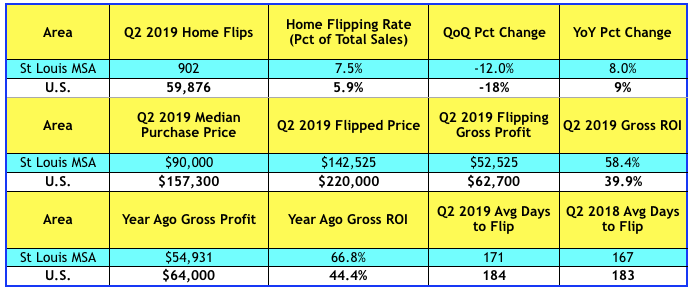 © 2019 – St Louis Real Estate News, all rights reserved
© 2019 – St Louis Real Estate News, all rights reserved
There were 528 homes “flipped” in the St Louis metro area during the first quarter of 2019, which equated to 7.7% of the total number of homes sold in the St Louis metro area during the quarter, according to data just released by ATTOM Data Research. This is down 14% from the 1st quarter of 2018 but does reflect a 3% increase from the prior quarter. As our table below shows, on a national level, house flipping accounted for 7.2% of the homes sold during the 1st quarter of this year, which is a 23% increase from the quarter before and an 8% increase from a year ago.
Definition of a “flipped” home…
For the purposes of this report, a flipped home is considered to be any home or condo that was sold during the first quarter of this year in an arms-length sale that had previously had an arms-length sale within the prior 12 months. Since homeowners don’t tend to buy a home only to turn around and resell it within a year, when this does occur it is typically the result of an investor buying a property, renovating it, then reselling it.
[xyz-ips snippet=”Foreclosures-For-Sale-and-Homes-For-Sale”]
St Louis House Flipping – 1st Quarter 2019
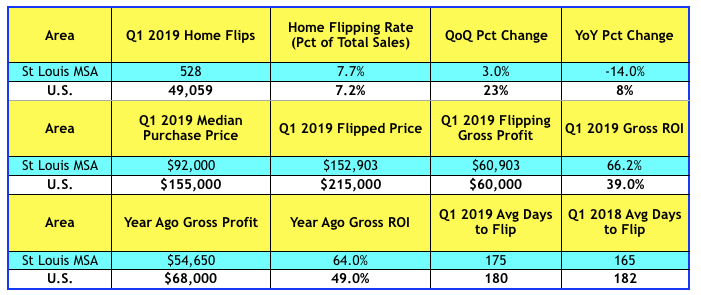
There were 3,143 home “flips” in the St Louis metro area during 2018, according to data just released by ATTOM Data Research. With 7.4% of homes sold in St Louis being a flip in 2018, this is a decline of 3.7% from a year ago. The peak number of flips in St Louis came in 2005 when there were 4,426 homes flipped.
What is meant by “flipped” home?
ATTOM Data considers any home or condo that was sold during the third quarter of this year in an arms-length sale that had previously had an arms-length sale within the prior 12 months as well as a “flip”. Since homeowners don’t tend to buy a home only to turn around and resell it within a year, when this does occur it is typically the result of an investor buying a property, renovating it, then reselling it.
[xyz-ips snippet=”Foreclosures-For-Sale-and-Homes-For-Sale”]
St Louis House Flips 2018

St Louis House Flips Average Gross Profit

There were 752 home “flips” in the St Louis metro area during the third quarter of this year, representing 6.5% of the homes sold during the period, according to data just released by ATTOM Data Research. This is a decline of 7.4% from the prior quarter and a decline of 2.0% from the same quarter last year.
What is meant by “flipped” home?
ATTOM Data considers any home or condo that was sold during the third quarter of this year in an arms-length sale that had previously had an arms-length sale within the prior 12 months as well as a “flip”. Since homeowners don’t tend to buy a home only to turn around and resell it within a year, when this does occur it is typically the result of an investor buying a property, renovating it, then reselling it.
Continue reading “The Number of Flipped Houses In St Louis Drops, As Do Profits On Them“
House flipping, something that has become quite popular among investors over the past few years and has even spawned several reality TV shows, continues to decline in terms of the number of flips. This is certainly not due to a lack of interest but instead a lack of opportunities. Many flipping opportunities are the result of foreclosures and with the mortgage delinquency rates continuing to improve resulting in declining foreclosure rates, the end result is few opportunities for investors to flip homes.
In St Louis, during the 2nd quarter of 2018, there were 835 homes flipped in the St Louis metro area, a decline of 23.0% from the quarter before and a 4.7% decline from a year ago. This is down 32.5% from the peak during the 3rd quarter of 2005 when there were 1,237 homes flipped in St Louis.
The table below shows the 2nd quarter house flipping data for St Louis, from ATTOM Data Services and includes the median size and age of the homes flipped, as well as median time to flip, prices and profits.
[xyz-ips snippet=”Foreclosures-For-Sale-and-Homes-For-Sale”]
St Louis House Flips – 2nd Quarter 2018
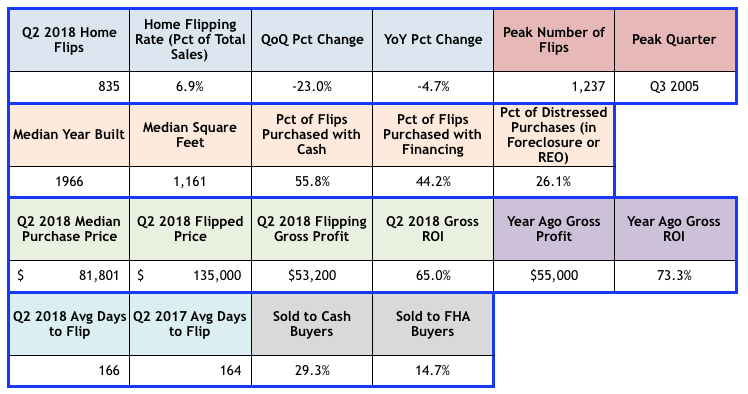
As the interest in investing in real estate in St Louis continues to increase, whether to buy, fix and flip or to buy and hold for rental, the number of opportunities to do so continues to decline. The primary source of “deals” for investors is typically “distressed” sales; property that has been foreclosed on and being resold, short sales or property in poor condition needing work. However, as our chart for St Louis MSA below reveals, the number of distressed home sales in St Louis has been steadily declining over the past 5 years.
The chart shows both the number of distressed sales for each month (the pink line) as well as the 12-month trend (green line) and both are on the decline. During the month of July 2018, there were 187 distressed home sales in St Louis, down 14% from 217 the month before and down 31% from last July when there were 272 distressed homes sold. For the 12-month period ended July 31, 2018, there were 2,787 distressed home sales, down 30% from the prior 12-month period when there were 3,965 distressed homes sold in the St Louis MSA.
[xyz-ips snippet=”Foreclosures-For-Sale-and-Homes-For-Sale”]
St Louis MSA Distressed Home Sales – Past 60 Months
(Click on Chart For Live, Interactive Chart)
During the first quarter of this year, there were 600 home “flips” in St Louis or about 8.6% of the homes sold in St Louis, according to data just released by ATTOM Data Research. This rate of flipped homes is up 5% from the prior quarter, however, is down 7% from a year ago. The decline certainly doesn’t have anything to do with a lack of interest by investors in flipping, it has more to do with a low inventory and declining mortgage delinquency and foreclosure rates reducing the opportunities.
What is a “flipped” home?
In the report issued by ATTOM Data Research, any home or condo that was sold during the first quarter of this year in an arms-length sale that had previously had an arms-length sale within the prior 12 months as well, was considered a “flip”. Since homeowners don’t tend to buy a home only to turn around and resell it within a year, when this does occur it is typically the result of an investor buying a property, renovating it, then reselling it.
[xyz-ips snippet=”Foreclosures-For-Sale-and-Homes-For-Sale”]
Continue reading “House Flipping Volume In St Louis Down From Year Ago“
St Louis flipped homes accounted for 6.6% of home sales in the St Louis MSA during the 3rd quarter of 2017, the lowest level since the 3rd quarter of 2016 when flips made up 6.3% of the St Louis home sales. For the purposes of this report, a “flip” was defined as a property that was sold in an arms-length sale for the second time within a 12-month period.
Slow times are good flip times…
As the table below shows, with very few exceptions, for the 17 year period covered in the table, home flips have accounted for a larger percentage of the overall home sales in St Louis during the slow-selling seasons, the 1st and 4th quarters. This makes sense as lenders are more apt to make deals toward the end of the year to get foreclosures off the books before closing out the year.
Opportunities to flip homes in St Louis on the decline…
As our chart below the table shows, the number of distressed home sales (foreclosures, short sales, and bank-owned property) in the St Louis area has steadily declined during the past 2 years as the economy, including the housing market, continues to improve.
Search St Louis Homes For Sale HERE
See ALL Homes That Will Be Open In St Louis This Weekend
Want to flip property? Check out my video on how to buy foreclosures here.
Home Flips in St Louis 2000-2017 – St Louis House Flipping

St Louis 5-County Core Market – Distressed Home Sales – Past 24 Months
Home flipping accounted for 7.3 percent of all the home sales in the St Louis MSA during the 2nd quarter of this year according to a report released today by Attom Data Solutions. This is a decrease of 15% from the prior quarter when 8.6% of the homes sold were flips and is an increase of 10.6% from a year ago when 6.6% of the homes sold in St Louis were flips, according to the report. For the purposes of this report, a “flip” was defined as a property that was sold in an arms-length sale for the second time within a 12-month period.
St Louis house flipping profit margins…
During the second quarter of 2017, the median purchase price of houses that were flipped was $75,000 and the median resale price, 163 days later on average, was $129,900 for a gross profit margin of $54,900. Before you get too excited though, remember this is just the gross margin between the price paid and the price resold at. The actual net profit would be much lower as there would be costs related to the acquisition and sale of the property as well as rehab/repair costs and carrying costs, none of which is available publicly, so we can just talk about gross margins here.
Search St Louis Homes For Sale HERE
See ALL Homes That Will Be Open In St Louis This Weekend
Want to flip property? Check out my video on how to buy foreclosures here.
Home Flips in St Louis 2000-2017 – St Louis House Flipping

Data Source – AttomData Solutions – Copyright 2017- St Louis Real Estate News – All Rights Reserved
St Louis 5-County Core Market – Distressed Home Sales – Past 24 Months
It’s good when the value of your home increases, right? Yes, generally, most homeowners, look at their homes as an investment in addition to shelter for their families so they are generally happy to see the value of their investment increase. The flip side of it is, homebuyers, particularly first-time buyers, would, of course, like to see lower prices and better value in the home they buy. The thing that helps balance out these competing interests is inflation, but more specifically, the rate of income growth.
Not to get into an economics lesson here (which I’m not qualified to teach anyway) but if homebuyers incomes increase at about the same rate as home prices (ditto for interest rates) then, more or less, the “affordability” of a home to a buyer remains the same. Problems arise when those things get out of whack, such as in the period from about 2000 through 2007 when home prices were increasing at a much higher rate than incomes were (and interest rates rose too making it even more fun) which eventually led to the housing bubble burst in 2008 and the real estate market crash.
Search St Louis Homes For Sale HERE
See ALL Homes That Will Be Open In St Louis This Weekend
Find the value of your home (or any home) online in under a minute!
Continue reading “City of St Louis Has Best Home Affordability In St Louis Area“
Home flipping accounted for 8.6 percent of all the home sales in the St Louis MSA during the 1st quarter of this year according to a report released today by Attom Data Solutions. This is an increase of 14.7% from the prior quarter when 7.5% of the homes sold were flips and is an increase of 6.2% from a year ago when 8.1% of the homes sold in St Louis were flips, according to the report. For the purposes of this report, a “flip” was defined as a property that was sold in an arms-length sale for the second time within a 12-month period.
St Louis house flipping profit margins…
During the first quarter of 2017, the median purchase price of houses that were flipped was $75,000 and the median resale price, 158 days later on average, was $129,400 for a gross profit margin of $54,400. Before you get too excited though, remember this is just the gross margin between the price paid and the price resold at. The actual net profit would be much lower as there would be costs related to the acquisition and sale of the property as well as rehab/repair costs and carrying costs, none of which is available publicly, so we can just talk about gross margins here.
Search St Louis Homes For Sale HERE
See ALL Homes That Will Be Open In St Louis This Weekend
Want to flip property? Check out my video on how to buy foreclosures here. Continue reading “Home Flipping In St Louis Hits Highest Level In 8 Years“
There are several ways to look at home prices and home affordability as well as to argue the merits of homeownership versus renting, however, one my favorite metrics to consider along these lines is the relationship between home prices and rental rates. Most home buyers, that are seeking a home to live in, never consider what the home they are considering purchasing would rent for, since that is not their intended use. However, there is a relationship between home values the potential rental income in that there is a tipping point reached when the cost of owning a home exceeds the cost of renting a comparable home in the same neighborhood by too much, there becomes an incentive to rent rather than buy. Along the same lines, if rental rates get so high that, for about the same money, or even less, one could buy the home they are renting, there exists a strong incentive to buy a home.
With this in mind, when you look at the chart below from the St Louis Federal Reserve, which shows the St Louis home price index, the blue line, and the Consumer Price Index for Rent, the red line, you can see there is a pretty significant gap between the two. The chart goes back to 1975 and, as you can see, historically the home price index and CPI for rents have increase at relatively similar rates, with home prices lagging slightly behind from about 1980 through around 2004 but, even then, there was a pretty similar trend. As the housing bubble in 2006 approached, you can see the home price trend shot upward and past rents only to fall sharply around 2008 after the housing bubble burst. Since hitting bottom around late 2011, home prices have been trending upward, but, as illustrated, there is a much larger gap between home prices and rents then is the historic norm which is a good thing with regard to home prices. Based upon what I see on the chart (you can click on the chart to be taken to our live, current version which is interactive) I would expect the gap between rents and home prices to close at some point in the near future. This can be accomplished in one of two ways: home prices can rise at a greater rate than rents rise, or rents can fall or remain flat, or, of course, some combination of the two. In either event I think this is good data to support sustained home prices and also shows that buying a home could well be a better investment than renting.
Search St Louis Homes For Sale HERE
See ALL Homes That Will Be Open In St Louis This Weekend
Want to flip property? Check out my video on how to buy foreclosures here. Continue reading “St Louis Home Prices Verses Rent Continues To Show Value In Home Prices“
Home flipping accounted for 8.1 percent of all the home sales in the St Louis MSA during the 1st quarter of this year according to a report released today by RealtyTrac. This is up 20 percent from the prior quarter however is a decline from the first quarter of 2015 when flipped homes accounted for 8.3% of all the homes sold.
Home flipping in St Louis peaked in 2006…
During the first quarter of 2016, over 1 out of every ten home sales (10.7%) in St Louis was a flip, the highest level ever seen in St Louis since RealtyTrac began tracking flips.
Search St Louis Homes For Sale HERE
See ALL Homes That Will Be Open In St Louis This Weekend
Want to flip property? Check out my video on how to buy foreclosures here. Continue reading “Home Flipping in St Louis Declines In 1st Quarter From Year Ago“
Flipping houses, something that went from something a few professional speculators only did years ago when I was actively buying homes for resale, became somewhat of a national pastime during the real estate boom years in the 2000 – 2007 period. House flipping in St Louis, while being done less than 10 years ago at nearly the peak of the bubble market, is still alive and well in St Louis. As the table below shows, during 2015 there were 2,386 homes flipped in the St Louis metro area, just about the same exact number as there were in 2014.
For the purposes of this article, a property that is sold, in an arms-length sale, for the second time within a 12-month period is considered a home flip.
St Charles County saw decline in house flipping…
As the data below illustrates, St Charles county was the only county in the St Louis core market that saw a decline in house flipping during 2015 from the year before and Franklin county saw the largest increase.
Gross profit on flips..
The second table down, shows the median gross profit, as well as return on investment (ROI) for house flips during 2015 by county.
Search St Louis Homes For Sale HERE
See ALL Homes That Will Be Open In St Louis This Weekend
Want to flip property? Check out my video on how to buy foreclosures here. Continue reading “House Flipping Activity In St Louis Last Year Same As Year Before“
Along with the end of 2015 came one of the busiest time periods for listings of homes for sale to expire. To put it in perspective, during the last two weeks of December, there were almost 1,300 listings that expired within the St Louis five-county core market, more than double the number of listings that expired during the last two weeks of November. While there is a logical reason that many sellers go off the market at year-end, such as the fact that, as the chart below shows, January is historically, and has been for the past 5 years as depicted, the worst month of the year for home sales and the month when homes sell for the lowest price of the year. However, on the flip side of things, it can also be the time when there is less competition from other listings, making it easier to sell.
Sellers markets neighborhoods with low inventory of homes for sale:
There are currently 30 cities in the St Louis area that have less than a 3-month supply of homes for sale (based upon the last 30 days of home sales) making them markets that favor sellers. The table below shows the top 14 sellers markets in St Louis, based upon inventory of homes for sale, all with just a 2 month or less supply of homes for sale. If you live in one of these neighborhoods and have considered selling, now would be the time to take advantage of the low inventory and beat the “spring-sellers” to the market!
Search St Louis Homes For Sale HERE
Find Your Home’s Value Online NOW!
See ALL Homes That Will Be Open In St Louis This Weekend
Get The Latest LIVE St Louis Home Prices, Sales and Other Market Data HERE
Continue reading “If You Own A Home In One of These Neighborhoods NOW Is The Time to Sell!“
